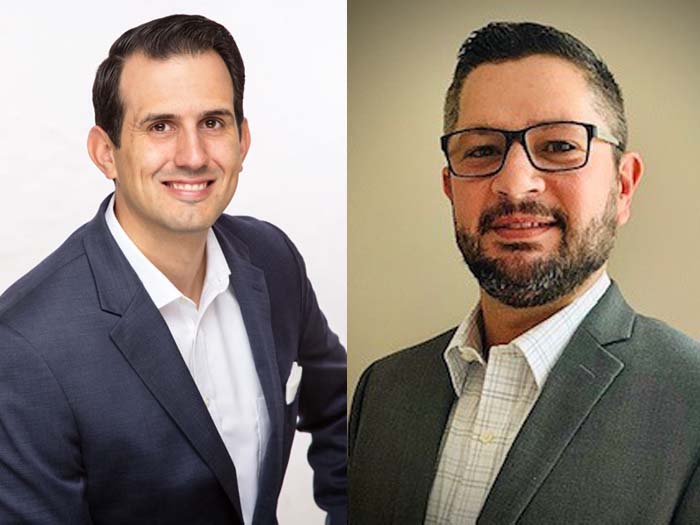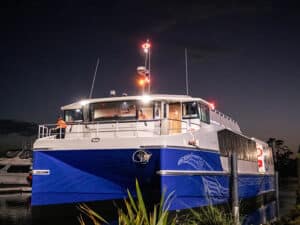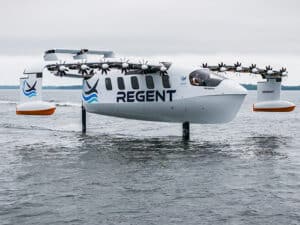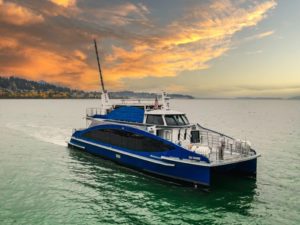
Q&A: 10 Minutes with Cummins and Wabtec Marine Propulsion
Written by Marine Log Staff
Tom Budija (right), director of marine business of Cummins and Gustavo Garza (left), business development leader with Wabtec.
[Sponsored Content]: Cummins has long provided engines, gensets, and other applications and accessories to ferries, tugboats, towboats, fishing vessels and more. Wabtec Corporation, of which Cummins has partnered with on various sales and service responsibilities in the U.S., provides the marine industry with diesel engines, onshore power supply, and other marine parts and accessories.
As a gold sponsor of Marine Log’s upcoming FERRIES 2021 conference, we talked to Tom Budija, director of marine business of Cummins and Gustavo Garza, business development leader with Wabtec about the work the company has done over the years, their current partnership, and looking ahead at what comes after Tier 4 engines.
Marine Log (ML): Can you explain to us the partnership Cummins and Wabtec have?
Tom Budija (Cummins) and Gustavo Garza (Wabtec): Cummins and Wabtec have worked in partnership since the mid-2000s as part of a collaboration with Cummins’ gulf region sales and service team. More recently, Cummins and Wabtec have expanded their partnership to include sales and service responsibilities for the east coast and parts distribution for the continental United States.
Cummins and Wabtec’s product lines complement each other to provide a broad range of solutions for customers across markets; Cummins provides high-speed diesel engines in lower power nodes (250 to 2,700hp.) and Wabtec provides medium speed diesel engines in higher power nodes (2,200 to 5,700 hp.). Cummins provides engineering expertise and next-level sales and service support to Wabtec’s product offerings in the market. We have valuable experience working with owner/operators, shipyards and naval architects that position us to support all marine projects and initiatives.
ML: Looking ahead, what comes after Tier 4?
Cummins: In the last decade, Cummins has taken significant strides to invest in new technologies, as they become viable solutions and alternatives to diesel power. Cummins New Power business unit focuses on research and innovation for our customers to stay at the forefront of low-carbon technologies. We are leaders in the developing fields of battery, fuel cell, and hydrogen production technologies.
Cummins is not waiting for the market to signal “what comes next” we are actively working to evaluate new technologies and how we choose the right solutions for the marine business that will be commercially scalable and sustainable. The marine business has been slower to adopt than other markets in the push for alternatives to diesel. Cummins has already provided 100+ electric school buses to the Blue Bird school bus company in the U.S., the world’s first hydrogen powertrain zero emissions commuter rail to Alstom in Germany, and a next generation PEM fuel cell electrolyzer in Canada (just to name a few of many projects). When the marine industry is ready to transition, Cummins will be ready with years of experience in tow.
We power the first commercial hydrogen fuel cell-powered ferry, the Sea Change. We have also collaborated with BAE Systems to produce various diesel-electric solutions. Cummins has seen the conversation transition from, “How do we make diesel cleaner?” to “How can we best achieve a zero-carbon solution?” No longer emissions reductions, it is now about decarbonization. In the ferry market specifically, the push for cleaner alternatives is no longer coming from the Environmental Protection Agency (EPA). We’re hearing these needs and desires come directly from our customers for the betterment of the environments in which we work.
Wabtec: Wabtec is constantly listening to our customers and working with them to help achieve their goals. As Cummins stated, we are also working to decarbonize our products by using alternative fuels and combining our engines with other technologies to ensure the best solution to an ever-evolving world and its demand for more power.
ML: Where are you at with dual-fuel engines that will burn LNG or methanol? What about fuels, such as ammonia and hydrogen?
Cummins and Wabtec: Both companies are currently researching and in development of multiple options. We continue to monitor the markets and work to determine what is the best path forward to meet the needs of our clients.
ML: Are you finding these solutions being added more frequently to newbuilds or retrofits?
Cummins:Cummins Marine ensures that we tailor every solution to the specific customer and project at hand. Our teams of highly trained application engineers are capable of ensuring that our Tier 4 solution can work in both new build or retrofit vessels. Our test vessel for the QSK38 Tier 4 was a repower opportunity with an older vessel, and we’re currently evaluating various opportunities for this unit in new build vessels as well.
Wabtec:In regards to Wabtec, customers are excited about being able to lower emissions without having to deal with the additional cost of urea and the logistics of it. With that being said, we have made huge strides in the dredging and ferry markets with new builds and retrofits and continue to expand our Tier 4 customer base.
ML: Can you outline a few recent projects you’ve collaborated on for the marine industry?
Cummins: Recently, Cummins was able to support the refit of the Anna C, which is owned by the Block Island Ferry. Built in 1986, the Anna C is U.S> Coast Guard certified for 1,285 passengers. She is powered by three Cummins QSK38 engines that help to reduce nitrogen oxide and particulate matter emissions. Another Block Island Ferry, Carol Jean, is also backed by Cummins power. The 33-year-old vessel operates a May through October schedule with three QSK38s propelling her ventures.
The Cecilia Ann is the newest member of the Long Island Ferry fleet. This catamaran was built in 2003 and she has a capacity of 600 passengers. Cruising at a speed of up to 30 knots, her four QSK38’s provide a smooth and reliable ride.
Wabtec: Cummins and Wabtec are currently completing the generator set packages for the NSMV training ships that will be used to train the next generations of mariners. We have worked on multiple dredge, tug, ATB and OSV projects together as well.
ML: What about urea for Tier 4 engines? What’s the availability of supply, and what’s the tankage and piping dosage?
Cummins: Cummins Tier 4 solutions utilize Diesel Exhaust Fluid (DEF) to assist the engine and aftertreatment in meeting EPA emissions standards. DEF is a mixture of urea and water that has been used to support the on-highway market since the early 2010s. Cummins has experience using DEF with our aftertreatment systems for the last decade-plus, so although this may be a newer concept in the marine industry—Cummins has years of quality experience with the solution and technology.
The general guidance for DEF storage onboard a vessel is to host 10% of the fuel capacity in DEF. Your vessel will typically require 6% of the fuel capacity in DEF, so 10% ensures you’re prepared for a safe and stress-free voyage.
Wabtec: One of the reasons Wabtec has had success in the medium speed market is the fact that our engines use an EGR (Exhaust Gas Recirculation) system that does not require UREA. This simplified system that meets Tier 4 requirements makes this a great product for clients.
ML: What are the largest ferries Cummins usually powers? What are the smallest that Wabtec powers?
Cummins and Wabtec: The Cummins product line provides high-speed diesels from 250 hp. to 2,700 hp. The Wabtec product line provides medium speed diesels from 2,200 hp. to 5,600 hp. Wabtec engines are ideal for fully-displacement vessels, whereas Cummins can be utilized in planning-hulls and semi-displacement vessels. The Cummins and Wabtec partnership allows us to power and service any application in the ferry market.




